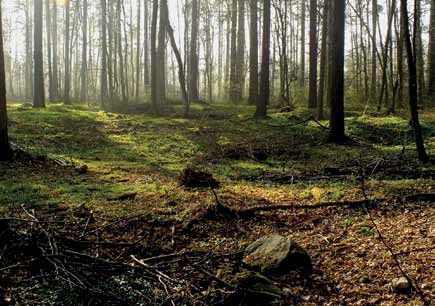YOUR BROWSER IS OUT-OF-DATE.
We have detected that you are using an outdated browser. Our service may not work properly for you. We recommend upgrading or switching to another browser.
Date: 03.10.2017 Category: science/research/innovation
A researcher from Wrocław University of Science and Technology has found a lost Medieval village Goschwitz, for which scientists had searched for a few decades. Archaeological studies on the site are to begin soon
 - The discovery was pure chance – admits Maria Legut-Pintal PhD from the Faculty of Architecture. – For a few years now, I have been analysing aerial laser scanning data. I decided to review materials related to sites investigated by my colleagues, thinking that I might find something useful for them. Site Gębczyce 3 on the border of Strzelińskie Hills was one of them. It caught my attention, as Krzysztof Fokt PhD from the Jagiellonian University was analysing it. There, I discovered a village for which Krzysztof, and even pre-war researchers before him, had been searching for a considerable time.
- The discovery was pure chance – admits Maria Legut-Pintal PhD from the Faculty of Architecture. – For a few years now, I have been analysing aerial laser scanning data. I decided to review materials related to sites investigated by my colleagues, thinking that I might find something useful for them. Site Gębczyce 3 on the border of Strzelińskie Hills was one of them. It caught my attention, as Krzysztof Fokt PhD from the Jagiellonian University was analysing it. There, I discovered a village for which Krzysztof, and even pre-war researchers before him, had been searching for a considerable time.
Goschwitz - a village that appeared in historical documents but was never heard of after that - has for years attracted the interest of scientists. The residents abandoned it just a few decades after they settled there. The exact location of the village was unknown before the Wrocław based researcher’s discovery. Scientists only knew that they should look for it in the area of Strzelińskie Hills.
Legut-Pintal PhD discovered the village in 2013, but she and Fokt PhD have been publicly talking about it only since a few months ago. First, they had to scientifically prove its existence, so site examinations and archive studies were to follow. Also, they were secretive about their discovery for fear treasure hunters might become attracted, as is often the case with such sites.
The existence of the village exactly in this area was also confirmed by pieces of pottery found here. The artefacts had been probably dug out by boars burrowing in this area. Thanks to the broken pieces, the scientists managed to date the village to the Middle Ages, between 13th and 15th century.
The researcher from WUST’s Faculty of Architecture stresses that the scientists are just beginning to discover the secrets of the village. So far, they have established that Goschwitz could have been an investment made by the Duke of Świdnica Bolko I the Strict, on whose orders the forest areas in the northern parts of Strzelińskie Hills were colonised. The investment proved to be ill-advised. – The village disappeared from historical sources in the second half of the 14th century. – explains Legut-Pintal PhD. – It probably turned out then that founding a village in an area with poor, rocky and sub-mountainous soil was a bad idea.
Thanks to the data obtained by aerial laser scanning, it was also possible to establish the location of two other lost villages near Goschwitz, i.e. Buchwald and Gębczyce (which had been translocated, as they lay in wetlands). – It is, therefore, the largest complex of lost neighbouring villages that has been discovered - the largest so far known in Poland and one of the largest ones in Europe. This is why we’re stressing the uniqueness of this discovery - enthuses Maria Legut-Pintal PhD.
Our site uses cookies. By continuing to browse the site you agree to our use of cookies in accordance with current browser settings. You can change at any time.